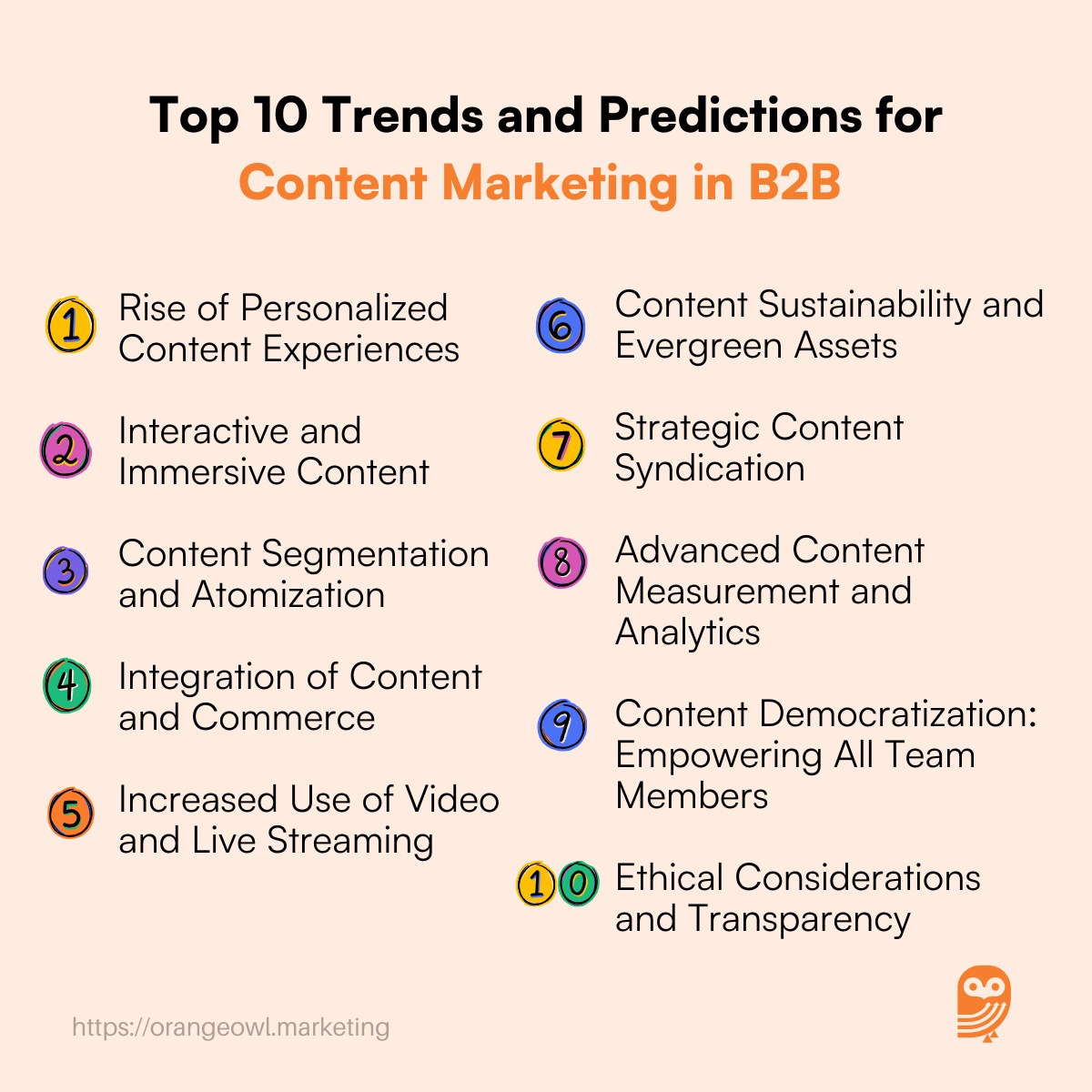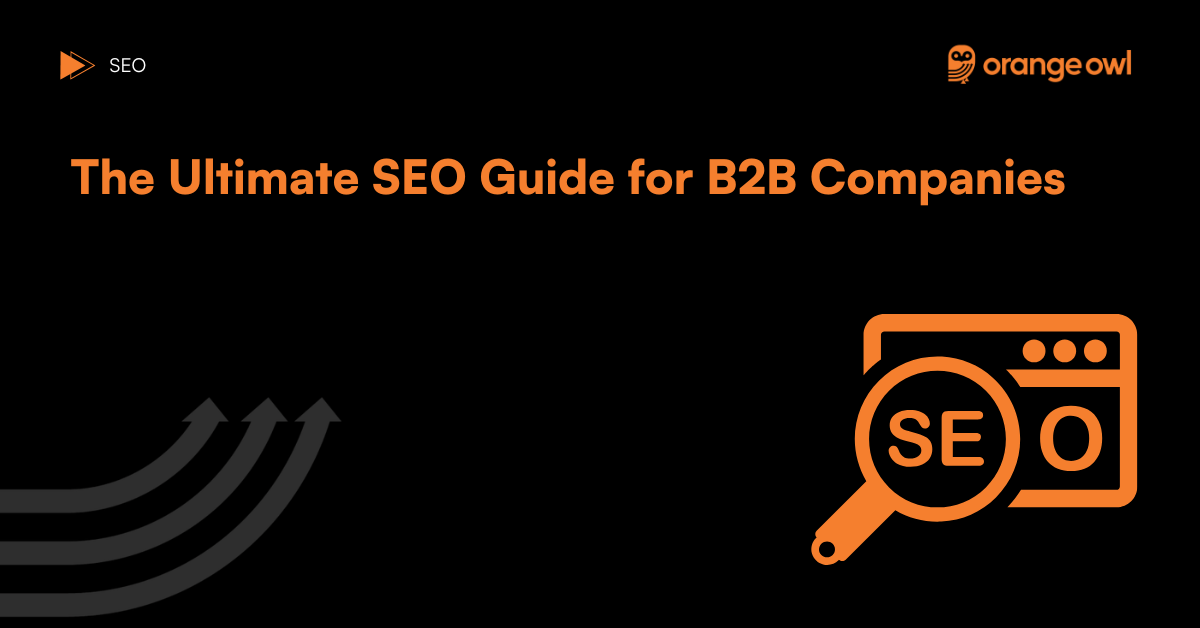Unlock Top 10 B2B Content Marketing Predictions and Trends for 2025
Vivek Goel
December 16, 2024

Table of Contents
Introduction
As we approach 2025, the dynamic field of content marketing is undergoing significant transformations, particularly in the B2B sector. With technological advancements and consumer behaviour shifts, B2B marketers must adapt to stay ahead. This blog post explores the top B2B content marketing predictions and trends for 2025, offering insights into strategies that can drive engagement and conversion in this evolving landscape.
Top 10 B2B Content Marketing Predictions and Trends for 2025
Prediction 1: Rise of Personalized Content Experiences
Insight: Personalization will continue to dominate, moving beyond basic data to leverage advanced AI for hyper-personalized content experiences.
Actionable Steps:
- Implement AI tools to analyze customer data and deliver content tailored to individual preferences and behaviours.
- Develop dynamic content that adapts based on the user’s interaction history.
Example: A B2B software company could use AI to offer personalized whitepapers or case studies based on the visitor’s past downloads and page views.
Prediction 2: Interactive and Immersive Content
Insight: As engagement becomes harder to sustain, interactive and immersive content forms such as augmented reality (AR) and virtual reality (VR) will become more prominent.
Actionable Steps:
- Invest in interactive tools like quizzes, polls, and AR/VR experiences to enrich content offerings.
- Explore partnerships with technology providers to create immersive product demos or virtual tours.
Example: A B2B construction equipment supplier might develop a VR application that lets prospects virtually operate machinery before purchase.

Prediction 3: Content Segmentation and Atomization
Insight: With the overload of content available, more precise segmentation and atomization of content will be crucial to ensure relevance and manageability.
Actionable Steps:
- Break down larger pieces of content into smaller, targeted pieces that address specific audience segments.
- Use analytics to understand which content types and topics perform best for different segments.
Example: A B2B healthcare marketing firm could segment its email campaigns by role—sending nurses detailed user case studies, while administrative buyers receive ROI-focused emails.
Prediction 4: Integration of Content and Commerce
Insight: The lines between content and commerce will continue to blur, with more direct paths from educational content to purchase opportunities.
Actionable Steps:
- Embed product links and purchasing options directly within informational content.
- Develop content that naturally leads into a sales funnel, such as detailed product guides or comparison charts.
Example: A B2B tech provider might integrate interactive product demos within blog posts or articles, with a seamless option to request a quote or demo.
Prediction 5: Increased Use of Video and Live Streaming
Insight: Video will remain a powerful medium for storytelling and engagement, with live streaming gaining traction due to its real-time interaction capabilities.
Actionable Steps:
- Expand video content strategies to include more how-to videos, interviews, and behind-the-scenes looks at your company.
- Leverage live streaming for events, product launches, and Q&A sessions to engage directly with your audience.
Example: A B2B software company could host live coding sessions or product development updates, engaging directly with users and gathering live feedback.
Prediction 6: Content Sustainability and Evergreen Assets
Insight: As content production becomes more resource-intensive, the focus will shift towards creating sustainable, evergreen content that remains relevant and drives traffic over time.
Actionable Steps:
- Focus on creating high-quality content that addresses timeless topics relevant to your industry.
- Regularly update existing content to keep it current and continue driving value from past investments.
Example: A B2B financial services firm might create a comprehensive guide to business financing that is periodically updated with new regulations and market conditions.
Prediction 7: Strategic Content Syndication
Insight: To expand reach and impact, strategic syndication partnerships will become essential, allowing companies to share content across platforms and with complementary businesses.
Actionable Steps:
- Identify potential partners with similar target audiences to share and co-create content.
- Use platforms like LinkedIn and industry blogs to syndicate content and reach a broader audience.
Example: A B2B marketing agency could partner with a sales enablement platform to co-produce a series of webinars and articles on aligning sales and marketing strategies.
Prediction 8: Advanced Content Measurement and Analytics
Insight: As content marketing matures, so will the need for more sophisticated measurement techniques to prove ROI and justify budget allocations.
Actionable Steps:
- Invest in advanced analytics tools that track user engagement, lead generation, and sales conversions from content.
- Set clear KPIs for each type of content and regularly review performance to optimize strategies.
Example: A B2B consulting firm might use analytics to track which types of content (e.g., blog posts, whitepapers, webinars) most effectively lead to consultation requests.
Prediction 9: Content Democratization – Empowering All Team Members
Insight: Empowering all team members to contribute to content creation will enhance authenticity and broaden the scope of your content.
Actionable Steps:
- Train and encourage employees from all departments to share insights, write articles, or participate in video content.
- Create a content calendar and guidelines to ensure consistency and quality across all contributions.
Example: A B2B manufacturing company might encourage engineers and product designers to write about their processes and innovations, providing a behind-the-scenes look at product development.
Prediction 10: Ethical Considerations and Transparency
Insight: As consumers become more concerned with ethics and corporate responsibility, transparent and ethically produced content will be crucial.
Actionable Steps:
- Ensure all content is ethically sourced and produced, with clear disclosures about partnerships and sponsored content.
- Build trust through transparency by openly discussing company values and practices in your content.
Example: A B2B company specializing in supply chain solutions could produce a transparency report detailing how their solutions contribute to ethical sourcing and sustainability.
Conclusion
For B2B marketers, 2025 will be a year of both challenges and opportunities in content marketing. By understanding and leveraging these top content marketing predictions and trends, you can create a robust strategy that not only reaches your target audience but also engages and converts them more effectively than ever before. Adaptability and a forward-thinking approach will be key to navigating the future of content marketing in the B2B space.
Frequently Asked Questions (FAQs) on B2B Content Marketing Predictions and Trends
Personalization goes beyond addressing customers by name—it’s about delivering content that resonates with their specific challenges, goals, and preferences. With the advancement of AI and machine learning, businesses can analyze vast amounts of customer data, including browsing history, purchase patterns, and engagement behavior. This data is then used to create hyper-targeted campaigns that feel relevant and tailored.
For example, a SaaS provider can send detailed whitepapers about security to IT managers, while offering ROI calculators to financial decision-makers within the same company. Personalization helps build trust, drive engagement, and significantly boost conversion rates.
Interactive content stands out in a crowded digital space because it actively involves the audience, making them participants rather than passive viewers. Tools like calculators, polls, and interactive infographics encourage users to engage, thereby increasing their time spent with the brand. This type of content also provides real-time feedback and data, helping marketers understand user preferences.
For instance, a manufacturing company could use an interactive tool that allows customers to configure and visualize their custom machinery. Such experiences enhance customer engagement, make complex information digestible, and can often lead directly to sales inquiries.
Content segmentation involves dividing your audience into specific groups based on criteria such as industry, job role, or stage in the buying journey. This allows marketers to deliver highly relevant content that speaks to the unique needs of each segment.
For instance, a B2B healthcare software company might send product case studies to potential customers in the research phase and pricing comparisons to those nearing a purchasing decision. By ensuring the right content reaches the right audience, businesses reduce inefficiencies and boost ROI by increasing conversion rates and customer satisfaction
Integrating content with commerce involves creating a seamless transition from educational materials to purchasing opportunities. This can be achieved by embedding clear calls to action (CTAs) like “Request a Demo” or “Get a Quote” within blog posts, videos, or webinars. Additionally, creating product-centric content, such as detailed guides or comparison charts, can help buyers make informed decisions while staying within your ecosystem.
For example, a cloud services provider might publish an article explaining cloud migration benefits, with a direct link to their consultation booking page, making the transition from learning to buying smooth and effortless.
Video content is highly effective because it combines visuals and audio to convey messages quickly and effectively. Professionals, especially in B2B, often prefer watching a concise explainer video over reading lengthy text.
Videos can showcase complex products in action, provide virtual tours, or share customer testimonials that build credibility. Live streaming takes this a step further, offering real-time interaction through Q&A sessions or product demonstrations.
A logistics company, for instance, could live-stream a walkthrough of their warehouse management system, demonstrating its efficiency and answering viewer questions directly.
Evergreen content focuses on topics that remain relevant over time, such as “Best Practices for B2B Lead Generation” or “How to Optimize Supply Chains.” Unlike time-sensitive posts, evergreen content continues to attract and engage readers long after publication. By periodically updating these assets with new insights or data, businesses can maintain their value and improve search engine rankings.
For example, a B2B financial services firm might publish an in-depth guide on securing business loans and update it annually to reflect the latest interest rates and policies, ensuring its ongoing utility.
Content syndication allows businesses to share their articles, videos, or other assets across third-party platforms, such as industry blogs, news outlets, or LinkedIn groups. This amplifies the content’s visibility, often exposing it to audiences that the company might not reach on its own. Strategic syndication involves partnering with complementary businesses or thought leaders to co-create and share content.
For instance, a B2B CRM provider could collaborate with a sales training company to publish a joint article on improving customer relationships, benefiting from each other’s established audience bases.
Advanced analytics platforms help B2B marketers track performance metrics, providing deep insights into user behavior. Tools like Google Analytics 4 offer detailed data on website traffic, user demographics, and engagement rates. HubSpot can track leads generated from specific content pieces, while tools like SEMrush can monitor keyword rankings and backlinks. Businesses should set clear KPIs for content—such as the number of leads generated, average time spent on page, or conversion rates—and use these insights to refine their strategy.
A B2B marketing firm might discover, for example, that webinars outperform blog posts in lead generation, prompting them to shift their focus.
Encouraging employees to contribute to content creation brings fresh perspectives and increases authenticity. Team members from different departments can share their expertise, showcasing the company’s knowledge and values. For instance, engineers can write about product innovations, while customer service reps can share success stories or common solutions. This not only humanizes the brand but also builds credibility.
A B2B software company might feature blogs written by developers explaining how they solve real-world problems, resonating with technical buyers looking for deeper insights.
In an era of increasing transparency and accountability, ethical content practices are critical for building trust. Businesses should disclose sponsorships, avoid exaggerated claims, and ensure all data cited is accurate and properly attributed. Ethical marketing also involves highlighting a company’s commitment to sustainability or social responsibility.
For example, a B2B supply chain company could create a content series on how they ensure ethical sourcing and reduced environmental impact, aligning with the values of their audience and reinforcing their credibility.


